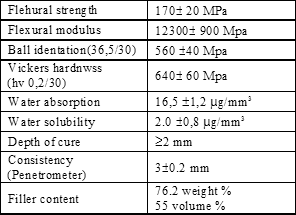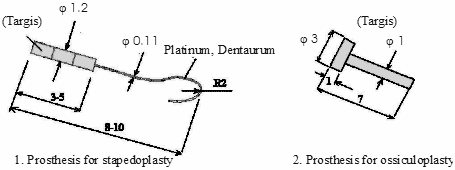

|
Journal Home Contents Preview Next |
Pro Otology
Balkan Journal of Otology & Neuro-Otology, Vol. 3, No 1:39-42 © 2003
All rights reserved. Published by Pro Otology Association
Vibration and Strength Theoretical - Experimental Studies of Prostheses for Ossiculoplasty and Stapedoplasty
*V. Milkov, †M. Milkov, †Y. Staychev
*Clinic of Otorhinolaryngology, Medical University, Varna
†Department of Technical Mechanics, Technical University, Varna
ABSTRACT
Hypothesis: The aim of the study is to prove the reliability on the examined prostheses for ossiculo- and stapedoplasty made of the materials “Targis” and “Materials” through well built experimental settings.
Background: The biomaterials used for the fabrication of prostheses for ossiculoplasty should meet a lot of requirements so that they can be used for the fabrication of prostheses for ossiculo- and stapedoplasty.
Methods: Vibration and strength studies were carried out. A special experimental setting was created for the experimental definition of the resonance states and dynamic loading of the prostheses
Results: In case of frequencies up to 800 Hz the prostheses work before the first resonance. The prostheses for stapedoplasty do not collapse; the loading device unrols the fibre. The prosthesis for ossiculoplasty collapsed in the place of the passage between the thin and the thick part.
Conclusions: The resonance states of the prostheses are over 2 kHz but they cannot be excited as the level of vibroshifts in case of noise up to 100 dB is less then 1 micron. Hence no dynamic problems are liable to occur.
The prostheses for stapedoplasty can withstand minimum straining equivalent to 133 gr. and the prostheses for ossiculoplasty–up to 846 gr.
Key words: Biomaterials, Ossicular prosthesis, Ossiculoplasty.
Pro Otology 1: 39-41, 2003
INTRODUCTION
The biomaterials used for the fabrication of prostheses for ossiculoplasty should meet a lot of requirements so that they can be used for the fabrication of prostheses for ossiculo- and stapedoplasty. After we had examined the biocompatibility of the materials - “Targis” and “Vectris”, we carried out studies with the prostheses, made of them, which we present, in the following material (1,2,3).
MATERIAL AND METHODS
| Table 1. Physical properties (In accordance with ISO 10477-Dentistri- Polymer based crown and bridge materials). |

|
The dimensions of the studied prostheses are shown on FIG. 1. The fibre of the first prosthesis on its part was two types - a platinum fibre with thickness of 0.11 mm and a fibre of dentaurum with thickness of 0.2 mm. The fibres are pressed into the ceromer with retention.
Vibration study
As the prostheses work in a sound field with frequency from 20 Hz to 20 kHz, a numerical analysis of the free vibrations was carried out with the help of the software package - SDAN – (4,5), based on the method of final elements, in order their resonance states to be established. The first two frequencies of the free vibrations and their corresponding forms of vibrating are shown on FIG. 2 (a prosthesis for stapedoplasty with a platinum fibre) and FIG. 3 (a prosthesis for ossiculoplasty). It was presumed in the analysis that the prostheses are loose (unattached), which corresponds more precisely to their working position. Module of elasticity of 160 MPa and specific gravity of 11 kN/m3 (according to data of (6,7,8), Table 1) was accepted for “Targis”.
The following experimental setting was created for the experimental definition of the resonance states and dynamic loading of the prostheses (FIG. 4): a sound generator, RFT SG201 type, producing a sinusoidal signal within the range from 20 Hz to 20 kHz, which is intensified by the intensifier, LV 102 (RFT) type and is passed to the vibrostand. The prostheses and sensor, KD35 - RFT type, which measures the level of vibrations, are fixed on the vibrostand with the help of an especially made for the purpose device. The device fixing the prostheses and the vibrosensor are shown in a close - up on FIG. 5. The level of vibrations were measured by a vibro - measuring device, RFT 00028 type, as a calibration table, RFT 11032 type, was used for warding off the signal. The level of the noise, created by the vibrostand was measured with the help of a precise noise meter, RFT 00017 type.

|
|
FIG 1. Dimensions of the studied prostheses. |
The experiment showed that in case of frequencies over 800 Hz and a level of noise - 100 dB the vibroshifts of the prostheses are under the threshold of responsiveness of the apparatuses – 1 micron. This proves that under real working conditions the loading of the prostheses is insignificantly small and by no means there can be problems connected with their strength. In case of frequencies up to 800 Hz the prostheses work before the first resonance, which is obvious from the numerical analysis.
Strength study
A possible destruction of the prostheses may most likely occur in the process of manipulation with them during operation. A special loading device was designed and constucted so as to establish the maximum exertion as a result of which they collapse – FIG. 6 and FIG. 7. The prostheses have been attached in a device and with the help of a special spring with very little hardness (16.6 gr./cm) they have been burdened by straining as the exertion has been measured by the magnitude of the deformations of the spring with a precision of 2 gr.

|
|
FIG 2. Forms of the free vibrations of prosthesis 1. |

|
|
FIG 3. Forms of the free vibrations of prosthesis 2. |
Each prosthesis was tested in two experiments. As a result of the experiment we found out the following:
The prostheses for stapedoplasty do not collapse and the loading device unrolls the fibre. The unwinding of the platinum fibre occurred as a result of strength equivalent to 133 gr. in case of a single winding of the fibre and to 630 gr. in case of a double winding. The unwinding of the fibre of dentaurum occurred as a result of strength equivalent to 200 gr. in case of a single winding and to 398 gr. in case of a double winding of the fibre.
The prosthesis for ossiculoplasty collapsed in the place of the passage between the thin and thick part as in the two experiments the destruction occurred as a result of strength equivalent to 946 gr. and 846 gr. resp.
CONCLUSIONS
The theoretical – experimental studies, which were carried out, allow us to make the following more important conclusions:
1. The resonance states of the prostheses are over 2 kHz but they cannot be excited as the level of vibroshifts in case of noise up to 100 dB is less then 1 micron. Hence no dynamic problems are liable to occur.
2. The prostheses for stapedoplasty can withstand minimum straining equivalent to 133 gr. and the prostheses for ossiculoplasty–up to 846 gr.
REFERENCES
Dalpino PH, Francischone CE, Ishikiriama A, Franco EB. Fracture resistance of teeth directly and indirectly restored with composite resin and indirectly restored with ceramic materials. Am J Dent 2002;15(6):389-94.
Janda R, Roulet JF, Wulf M, Tiller HJ. Resin/Resin bonding: a new adhesive technology. J Adhes Dent 2002;4(4):299-308.
Saygili G, Sahmali SM, Demirel F. The effect of placement of glass fibers and aramid fibers on the fracture resistance of provisional restorative materials. Oper Dent 2003;28(1):80-5.
Koike T, Wada H, Kobayaschi T. Alysis of the finite-element method of transfer function of reconstructed middle ears and their postoperative chnges. In: Merchant JJ and SN eds. The Function and Mechanics of Normal, Diseased and Reconstructed Middle Ears. Hague: Kugler Publications, 2000:309-20.
Milkov M, Fiolkovski K, Nedev N, Gabrovski R. Modern numeral methods for analysis of construktions. TU Varna, 1999, Varna.
Eiber A, Freitag HG, Schimanski G, Zenner HP. On the coupling of prostheses to the middle ear structure and its influence on sound transfer. In: Merchant JJ and SN eds. The Function and Mechanics of Normal, Diseased and Reconstructed Middle Ears. Hague: Kugler Publications, 2000: 321-5.
Kwok P, Fisch U, Strutz J, May J. Stapes surgery: How precisely do different prosteses attach to the long process of incus with different instruments and different surgeons? Otology & Neurotology 2002;23:289-95.
Gan RZ, Sun G, Robert K, et al. Tree-dimentsional modeling of middle ear biomechanics and its applications. Otology & Neurotology 2002;23:271-80.
|
Pro Otology |
Journal Home Contents Preview Next |